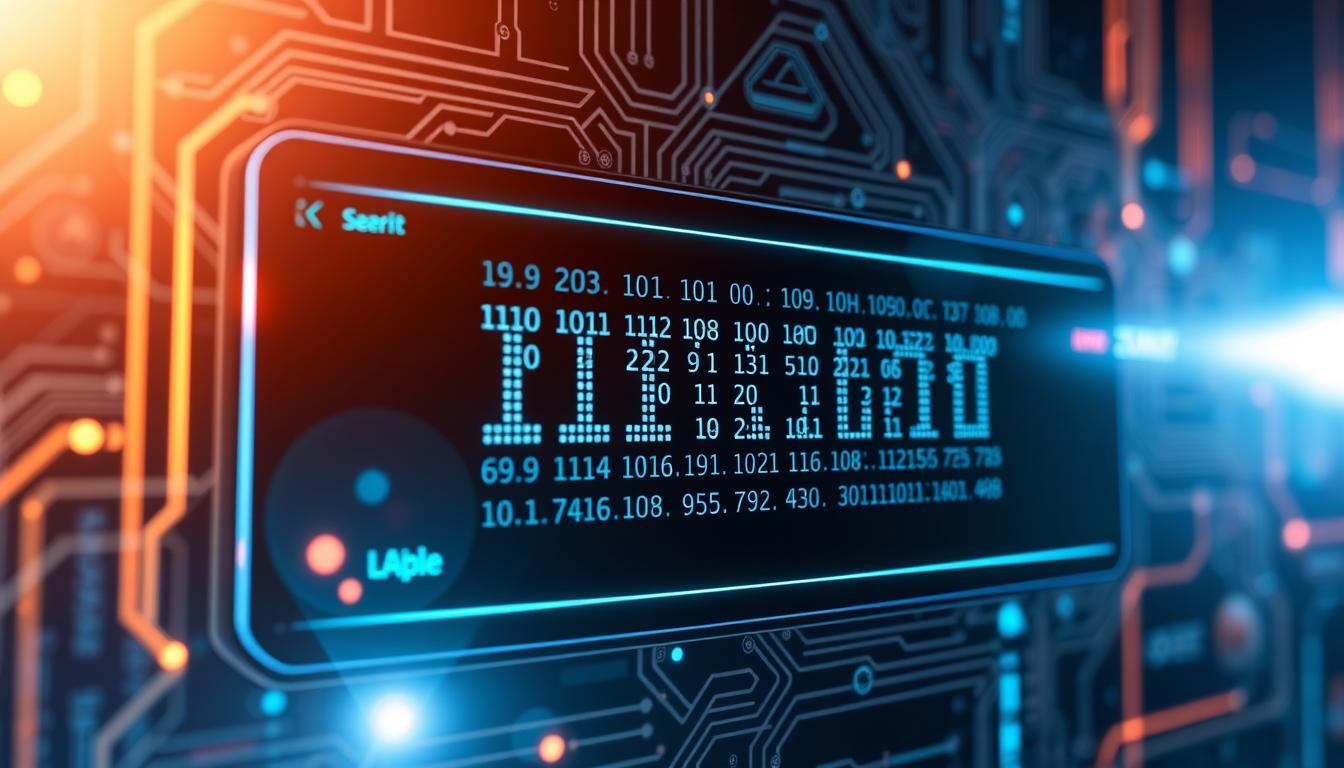Binary to Text Translator: Easily Convert Binary Codes
When you work with digital data, you might see binary codes that need to be turned into text. A binary translator or converter is a great tool for this job. It lets you quickly change binary codes into text that you can read. This is really helpful for students learning about binary code and for professionals working with data encryption or digital communications.
A binary to text converter makes working with binary data easier. It lets you quickly convert binary codes. This way, you can focus on more complex tasks and projects. Whether you’re working on a project with binary code or just need to translate some data, a binary translator saves a lot of time.
Using a binary translator or converter also helps you understand binary code better. By easily converting binary codes, you learn more about the technology behind it. This knowledge is useful in many digital communication applications.
Key Takeaways
- You can use a binary translator to instantly convert binary codes into readable text.
- A binary to text converter can be a valuable tool for students and professionals working with digital data.
- Using a binary translator can help you to better understand how binary code works and how it is used in digital communications.
- A binary to text converter can save you time and effort when working with binary data.
- You can use a binary translator to work more efficiently with binary codes and focus on more complex tasks.
- A binary to text converter can help you to gain a deeper understanding of the underlying technology used in digital communications.
Understanding Binary Code and Its Importance
As you explore computer science, you’ll learn about binary code. It’s the core of digital communication and data storage. Let’s dive into what binary code is and why it matters in today’s tech world.
The binary number system uses only two digits: 0 and 1. This makes it simple for computers to process and store data. Think of binary code as a set of instructions for computers to follow.
What Is Binary Code?
Binary code represents text, images, and data using 0s and 1s. It’s how computers talk to each other. For example, the text you’re reading can be turned into binary code.
How Binary Communication Works
Binary communication sends data between devices using binary code. This lets devices understand and carry out tasks. The key to this is binary language converters, which help computers get the data.
The Role of Binary in Modern Computing
In today’s tech, binary code is key for many things. It’s used in data sending, memory handling, and digital signal processing. Binary language converters are vital for smooth communication and data processing.
How Our Binary Translator Works
Our binary conversion tool quickly turns binary code into text you can read. It uses complex algorithms to understand binary sequences. These algorithms then match them to ASCII or Unicode characters. You can easily convert binary codes with our tool.
The tool starts by looking at the binary input, which is just 0s and 1s. It then finds patterns in the code. This lets it accurately translate the binary into text. This process is fast, making our tool great for working with binary.
Our tool can handle different binary formats and character sets. This makes it useful in many fields, like programming and web development. It saves you time by quickly converting binary to text.
Our tool is also very accurate. It has a strong system to catch and fix errors. This means you can trust the results, whether for work or personal use. With its ease, speed, and accuracy, our tool is ideal for converting binary to text.
Step-by-Step Guide to Converting Binary to Text
To translate binary to text, follow a few steps. First, make sure your binary input is correct. Check for any mistakes in the code.
Then, use a translation tool to change the binary code into text. This tool will turn your binary into text. It’s important to pick a good tool for accurate results.
Preparing Your Binary Input
When getting ready your binary input, make sure it’s formatted right. Look for any missing or extra digits. Use a binary editor or text editor to fix any issues.
Using the Translation Tool
After getting your binary input ready, use the translation tool. It will change the binary code into text. Then, you can use this text for what you need it for.
Understanding the Output
After using the tool, you’ll get a text output. This is the result of the binary to text translation. You can use this text to talk to others or put into a computer system.
Some important things to remember when converting binary to text are:
- Make sure the binary code is correct and error-free
- Choose a reliable translation tool
- Check if the output is accurate
By following these steps and tips, you can easily convert binary to text and get the results you want.
Common Applications of Binary Translation
Exploring binary code reveals many uses for binary translation. A binary code converter helps both professionals and hobbyists. It lets them decode and analyze binary data. This is key in data analysis and cryptography.
In digital forensics, it helps recover data from damaged files. In software development, it’s used to understand how software works. A binary code converter can also decode intercepted communications, like network packets or malware code.
Binary translation has many uses. It’s growing as technology gets better.
Some main uses of binary translation are:
- Data analysis and recovery
- Cryptography and cybersecurity
- Digital forensics and incident response
- Software development and reverse engineering
Using a binary code converter lets you understand binary code better. It’s a vital skill in today’s tech world. Whether you’re a pro or just starting, learning binary translation is worth it.
| Application | Description |
|---|---|
| Data Analysis | Extracting insights from large datasets |
| Cryptography | Decoding encrypted messages |
| Digital Forensics | Recovering data from corrupted files |
| Software Development | Reverse-engineering software |
Advanced Features of Our Binary Translator Tool
Our online binary translator has cool features that make it stand out. These features help you translate binary more efficiently and accurately. You’ll find it easy to convert and explore new things with our tool.
It has batch processing capabilities for converting many binary strings at once. This saves you a lot of time and effort. Plus, it has error detection and correction mechanisms to ensure your translations are spot on, even with mistakes.
Custom Format Options
Our tool also lets you choose custom formats for your binary. This means it works well with lots of different encoding schemes. Whether you’re using ASCII, Unicode, or something else, our translator can handle it.
Some key benefits of our advanced features include:
- Increased efficiency with batch processing
- Improved accuracy with error detection and correction
- Enhanced flexibility with custom format options
Batch Processing Capabilities
| Feature | Description |
|---|---|
| Batch Processing | Convert multiple binary strings simultaneously |
| Error Detection and Correction | Ensure accurate translations with imperfect inputs |
| Custom Format Options | Cater to specific binary encoding schemes or output preferences |
Using these advanced features, you can get the most out of our online binary translator. It makes your binary translation work easier and faster.
Binary to Text vs. Other Conversion Methods
Working with binary code often requires converting it to different formats. A binary to decimal converter is handy in some cases. But, it’s key to know the special benefits and uses of each conversion type.
Converting binary to text is often the best choice for big data. Yet, converting to decimal or hexadecimal might be better in other cases. Here are some times when each method shines:
- Binary to text: great for turning binary code into text we can read, like in programming or data storage.
- Binary to decimal: perfect for changing binary numbers to decimal for math or data analysis.
- Binary to hexadecimal: useful for making binary code more compact and easy to read, like in programming or sending data.
Knowing the differences between these methods helps you pick the right one for your needs. Using the best method can make your work easier and more efficient.
In summary, binary to text conversion is just one of many options. It’s vital to grasp the unique advantages and uses of each method to fully utilize your binary code.
| Conversion Method | Description | Use Cases |
|---|---|---|
| Binary to Text | Converts binary code to human-readable text | Programming languages, data storage |
| Binary to Decimal | Converts binary numbers to decimal numbers | Mathematical operations, data analysis |
| Binary to Hexadecimal | Converts binary code to a compact and readable format | Programming languages, data transmission |
Troubleshooting Common Binary Translation Issues
Using a binary string converter can sometimes lead to problems. These issues can make it hard to convert binary to text. It’s important to find and fix these problems quickly. Issues include error messages, wrong binary input, and problems with character encoding.
Knowing why these problems happen is key to solving them. Error messages might pop up if the binary input is wrong or if the converter doesn’t work well with your system. If the binary input is not right or is damaged, it won’t work. Also, if the encoding doesn’t match, you might face character encoding challenges.
Error Messages and Solutions
- Make sure the input format is correct for the binary format needed.
- Check if the binary string converter works with your system and data.
- Look at the user manual or online help for specific troubleshooting tips for your converter.
Invalid Binary Input Problems
To fix problems with invalid binary input, try these steps:
- Double-check the binary input for any mistakes or damage.
- Use a binary string converter that can find and fix errors itself.
Character Encoding Challenges
To tackle character encoding problems, consider these steps:
| Encoding Scheme | Compatibility |
|---|---|
| ASCII | Most binary string converters |
| UTF-8 | Many modern binary string converters |
By understanding and tackling these common issues, you can make sure your binary to text conversions work well with your binary string converter.
Best Practices for Binary Code Translation
Working with binary code requires following best practices for accurate and efficient translation. A good binary translator is key to achieving this. Start by organizing your binary data in a logical and consistent way. This makes it easier to translate.
Here are some important tips to remember:
- Check the integrity of your binary data before translation to avoid mistakes.
- Choose a trusted binary translator for accurate results.
- Keep a record of your translation process and results for later use.
By following these best practices, you can make your binary code translation smoother and more effective. Always pick a reputable binary translator for reliable translations.
| Best Practice | Description |
|---|---|
| Data Verification | Check your binary data’s integrity before translating. |
| Translator Selection | Choose a trusted and reliable binary translator. |
| Documentation | Document your translation process and results for future reference. |
By using these best practices in your workflow, you can ensure efficient and accurate binary code translation. This maximizes your use of the binary translator.
Tips for Efficient Binary Conversion
Working with big binary datasets needs a good plan for fast conversion. A top-notch binary conversion tool is key to making your work smoother and cutting down on mistakes. It helps you keep your data in order, making it easier to handle big amounts of information.
To check if your translations are right, try cross-checking and spot-checking. These steps mean comparing your work with the original binary code. This way, you can save time and lower the chance of mistakes in your projects.
Organizing Large Binary Datasets
Handling big binary datasets can seem tough, but it’s doable with the right steps. Here are some tips to help you start:
- Use a binary conversion tool to sort and focus on your data
- Divide big datasets into smaller parts that are easier to handle
- Use labels and tags to mark and track certain data points
Verifying Translation Accuracy
It’s very important to make sure your binary translations are correct. Here are some ways to do it:
- Cross-referencing: compare your translated data with the original binary code
- Spot-checking: pick random data points to check if they’re right
- Using a binary conversion tool with built-in check features
By following these tips and using a good binary conversion tool, you can make your work flow better and get accurate results.
| Binary Conversion Tool Features | Description |
|---|---|
| Batch Processing | Process large datasets quickly and efficiently |
| Error Detection and Correction | Automatically detect and correct errors in your binary code |
| Custom Format Options | Choose from a variety of output formats to suit your needs |
Conclusion: Mastering Binary Translation for Your Needs
In this guide, you’ve learned about binary translation and its key role in today’s tech world. You now know how to use our binary translator tool. This knowledge helps you solve many data conversion problems.
If you’re into coding, data analysis, or just tech curiosity, this skill is vital. It lets you easily switch between binary and text. Use it in your work, studies, or just for fun. The world of possibilities is wide open.
Binary translation is more than just tech skills. It opens doors to understanding digital technology better. Keep exploring and using our binary translator tool. It will boost your skills and keep you ahead in the tech world.
Start your journey in mastering binary translation. It’s a skill that will help you a lot in the future. Enjoy the process of learning and translating!














Post Comment